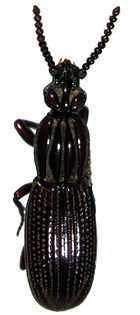Rhysodidae
| Wrinkled bark beetle | |
|---|---|
 | |
| Kaveinga lusca | |
| Scientific classification | |
| Kingdom: | Animalia |
| Phylum: | Arthropoda |
| Class: | Insecta |
| Order: | Coleoptera |
| Suborder: | Adephaga |
| Family: | Rhysodidae Laporte, 1840 |
| Genera | |
|
About 20, see text | |
Rhysodidae (sometimes called wrinkled bark beetles) is a family of beetles, consisting of several hundred species in about 20 genera.
These beetles are elongate, in size ranging from 5–8 mm, and color ranging from a reddish brown to black. Both the thorax and the elytra are deeply grooved lengthwise, thus giving these beetles their common name. The head is also grooved, and posteriorly constricted into a short but visible "neck". The 11-segment antennae are short, resembling a string of beads, while the mandibles lack cutting edges and are thus nonfunctional. The front legs are short and strongly built,
Adults and larvae live in moist rotten wood that is infested with slime moulds, which are believed to be their diet. Instead of using their mandibles to bite, they use the anterior edge of the mentum and swivel their heads to cut off pieces of food. Adults do not make burrows, instead just squeezing between the cell layers of the decomposed wood, generally leaving no visible trace of their passage, while larvae live in short tunnels.
They occur on all continents with forested areas, the richest fauna being found in New Guinea, Indonesia, the Philippines, and northern South America.
Classification remains controversial, with specialist Ross T. Bell arguing for placement as a tribe Rhysodini of Carabidae, while R. G. Beutel and others argue that larval characteristics indicate that rhysodids are their own family.
Genera include:
- Clinidium
- Omoglymmius
- Rhysodes
References
- Ross H. Arnett, Jr. and Michael C. Thomas, American Beetles (CRC Press, 2001)
External links
![]() Data related to Rhysodidae at Wikispecies
Data related to Rhysodidae at Wikispecies